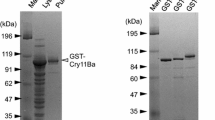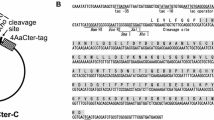Abstract
Bacillus thuringiensis (Bt) produces insecticidal toxins active against insects. Cry4B, one of the major insecticidal toxins produced by Bt subsp. israelensis, is highly toxic to mosquitoes in the genus Aedes: the major vectors of dengue, yellow fever, and chikungunya. Previous work has shown that Cry4B binds to several mid-gut membrane proteins in Aedes aegypti larvae including prohibitin, a protein recently identified as a receptor that also mediates entry of dengue virus into Aedes cells. This study confirms the interaction between Cry4B and prohibitin by co-immunoprecipitation analysis and demonstrates colocalization of prohibitin and Cry4B by confocal microscopy. While activated Cry4B toxin showed high larvicidal activity, it was not cytotoxic to two Aedes cell lines, allowing determination of its effect on dengue virus infectivity in the absence of Cry4B-induced cell lysis. Pre-exposure of Aedes cells to Cry4B resulted in a significant reduction in the number of infected cells compared to untreated cells.




Similar content being viewed by others
References
Guzman MG, Halstead SB, Artsob H, Buchy P, Farrar J, Gubler DJ, Hunsperger E, Kroeger A, Margolis HS, Martinez E, Nathan MB, Pelegrino JL, Simmons C, Yoksan S, Peeling RW (2010) Dengue: a continuing global threat. Nat Rev Microbiol 8(12 Suppl):S7–S16. doi:10.1038/nrmicro2460
Challacombe JF, Altherr MR, Xie G, Bhotika SS, Brown N, Bruce D, Campbell CS, Campbell ML, Chen J, Chertkov O, Cleland C, Dimitrijevic M, Doggett NA, Fawcett JJ, Glavina T, Goodwin LA, Green LD, Han CS, Hill KK, Hitchcock P, Jackson PJ, Keim P, Kewalramani AR, Longmire J, Lucas S, Malfatti S, Martinez D, McMurry K, Meincke LJ, Misra M, Moseman BL, Mundt M, Munk AC, Okinaka RT, Parson-Quintana B, Reilly LP, Richardson P, Robinson DL, Saunders E, Tapia R, Tesmer JG, Thayer N, Thompson LS, Tice H, Ticknor LO, Wills PL, Gilna P, Brettin TS (2007) The complete genome sequence of Bacillus thuringiensis Al Hakam. J Bacteriol 189(9):3680–3681
Berry C, O’Neil S, Ben-Dov E, Jones AF, Murphy L, Quail MA, Holden MT, Harris D, Zaritsky A, Parkhill J (2002) Complete sequence and organization of pBtoxis, the toxin-coding plasmid of Bacillus thuringiensis subsp. israelensis. Appl Environ Microbiol 68(10):5082–5095
Crickmore N, Bone EJ, Williams JA, Ellar DJ (1995) Contribution of the individual components of the delta-endotoxin crystal to the mosquitocidal activity of Bacillus thuringiensis subsp. israelensis. FEMS Microbiol Lett 131:249–254
Poncet S, Delécluse A, Klier A, Rapoport G (1995) Evaluation of synergistic interactions among the CryIVA, CryIVB, and CryIVD toxic components of B. thuringiensis subsp. israelensis crystals. J Invertebr Pathol 66:131–135
Boonserm P, Davis P, Ellar DJ, Li J (2005) Crystal structure of the mosquito-larvicidal toxin Cry4Ba and its biological implications. J Mol Biol 348(2):363–382
Boonserm P, Mo M, Angsuthanasombat C, Lescar J (2006) Structure of the functional form of the mosquito larvicidal Cry4Aa toxin from Bacillus thuringiensis at a 2.8-angstrom resolution. J Bacteriol 188(9):3391–3401
de Maagd RA, Bravo A, Berry C, Crickmore N, Schnepf HE (2003) Structure, diversity, and evolution of protein toxins from spore-forming entomopathogenic bacteria. Annu Rev Genet 37:409–433
Aronson AI, Shai Y (2001) Why Bacillus thuringiensis insecticidal toxins are so effective: unique features of their mode of action. FEMS Microbiol Lett 195(1):1–8
de Maagd RA, Bravo A, Crickmore N (2001) How Bacillus thuringiensis has evolved specific toxins to colonize the insect world. Trends Genet 17(4):193–199
Zhang X, Candas M, Griko NB, Taussig R, Bulla LA Jr (2006) A mechanism of cell death involving an adenylyl cyclase/PKA signaling pathway is induced by the Cry1Ab toxin of Bacillus thuringiensis. Proc Natl Acad Sci USA 103(26):9897–9902. doi:10.1073/pnas.0604017103
Buzdin AA, Revina LP, Kostina LI, Zalunin IA, Chestukhina GG (2002) Interaction of 65- and 62-kD proteins from the apical membranes of the Aedes aegypti larvae midgut epithelium with Cry4B and Cry11A endotoxins of Bacillus thuringiensis. Biochemistry (Mosc) 67(5):540–546
Fernandez-Luna MT, Lanz-Mendoza H, Gill SS, Bravo A, Soberon M, Miranda-Rios J (2010) An alpha-amylase is a novel receptor for Bacillus thuringiensis ssp. israelensis Cry4Ba and Cry11Aa toxins in the malaria vector mosquito Anopheles albimanus (Diptera: Culicidae). Environ Microbiol 12(3):746–757. doi:10.1111/j.1462-2920.2009.02117.x
Bayyareddy K, Andacht TM, Abdullah MA, Adang MJ (2009) Proteomic identification of Bacillus thuringiensis subsp. israelensis toxin Cry4Ba binding proteins in midgut membranes from Aedes (Stegomyia) aegypti Linnaeus (Diptera, Culicidae) larvae. Insect Biochem Mol Biol 39(4):279–286. doi:10.1016/j.ibmb.2009.01.002
Artal-Sanz M, Tsang WY, Willems EM, Grivell LA, Lemire BD, van der Spek H, Nijtmans LG (2003) The mitochondrial prohibitin complex is essential for embryonic viability and germline function in Caenorhabditis elegans. J Biol Chem 278(34):32091–32099
He B, Feng Q, Mukherjee A, Lonard DM, DeMayo FJ, Katzenellenbogen BS, Lydon JP, O’Malley BW (2008) A repressive role for prohibitin in estrogen signaling. Mol Endocrinol 22(2):344–360
Kasashima K, Sumitani M, Satoh M, Endo H (2008) Human prohibitin 1 maintains the organization and stability of the mitochondrial nucleoids. Exp Cell Res 314(5):988–996
Merkwirth C, Langer T (2009) Prohibitin function within mitochondria: essential roles for cell proliferation and cristae morphogenesis. Biochim Biophys Acta 1793(1):27–32. doi:10.1016/j.bbamcr.2008.05.013
Ikonen E, Fiedler K, Parton RG, Simons K (1995) Prohibitin, an antiproliferative protein, is localized to mitochondria. FEBS Lett 358(3):273–277
Nijtmans LG, de Jong L, Artal Sanz M, Coates PJ, Berden JA, Back JW, Muijsers AO, van der Spek H, Grivell LA (2000) Prohibitins act as a membrane-bound chaperone for the stabilization of mitochondrial proteins. EMBO J 19(11):2444–2451
Thompson WE, Branch A, Whittaker JA, Lyn D, Zilberstein M, Mayo KE, Thomas K (2001) Characterization of prohibitin in a newly established rat ovarian granulosa cell line. Endocrinology 142(9):4076–4085
Wang S, Fusaro G, Padmanabhan J, Chellappan SP (2002) Prohibitin co-localizes with Rb in the nucleus and recruits N-CoR and HDAC1 for transcriptional repression. Oncogene 21(55):8388–8396
Kolonin MG, Saha PK, Chan L, Pasqualini R, Arap W (2004) Reversal of obesity by targeted ablation of adipose tissue. Nat Med 10(6):625–632
Sharma A, Qadri A (2004) Vi polysaccharide of Salmonella typhi targets the prohibitin family of molecules in intestinal epithelial cells and suppresses early inflammatory responses. Proc Natl Acad Sci USA 101(50):17492–17497
Kuadkitkan A, Wikan N, Fongsaran C, Smith DR (2010) Identification and characterization of prohibitin as a receptor protein mediating DENV-2 entry into insect cells. Virology 406(1):149–161. doi:10.1016/j.virol.2010.07.015
Wikan N, Kuadkitkan A, Smith DR (2009) The Aedes aegypti cell line CCL-125 is dengue virus permissive. J Virol Methods 157(2):227–230
Singh KRP (1967) Cell cultures derived from larvae of Aedes albopictus (Skuse) and Aedes aegypti (L.). Curr Sci 36:506–508
Sakoonwatanyoo P, Boonsanay V, Smith DR (2006) Growth and production of the dengue virus in C6/36 cells and identification of a laminin-binding protein as a candidate serotype 3 and 4 receptor protein. Intervirology 49(3):161–172
Delécluse A, Poncet S, Klier A, Rapoport G (1993) Expression of cryIVA and cryIVB genes, independently or in combination, in a crystal-negative strain of Bacillus thuringiensis subsp. israelensis. Appl Environ Microbiol 59:3922–3937
Monnerat RG, Batista AC, de Medeiros PT, Martins ES, Melatti VM, Praça LB, Dumas VF, Morinaga C, Demo C, Gomes ACM, Falcão R, Siqueira CB, Silva-Werneck JO, Berry C (2007) Screening of Brazilian Bacillus thuringiensis isolates active against Spodoptera frugiperda, Plutella xylostella and Anticarsia gemmatalis. Biol Control 41(3):291–295
Silva-Filha MH, Nielsen-Leroux C, Charles J-F (1997) Binding kinetics of Bacillus sphaericus binary toxin to midgut brush-border membranes of Anopheles and Culex sp. mosquito larvae. Eur J Biochem 247(3):754–761
Klomporn P, Panyasrivanit M, Wikan N, Smith DR (2011) Dengue infection of monocytic cells activates ER stress pathways, but apoptosis is induced through both extrinsic and intrinsic pathways. Virology 409(2):189–197. doi:10.1016/j.virol.2010.10.010
Guo S, Liu M, Peng D, Ji S, Wang P, Yu Z, Sun M (2008) New strategy for isolating novel nematicidal crystal protein genes from Bacillus thuringiensis strain YBT-1518. Appl Environ Microbiol 74(22):6997–7001. doi:10.1128/AEM.01346-08
Harlow E, Lane D (1988) Antibodies a laboratory manual. Cold Spring Harbor Press, Cold Spring Harbor, p 449
Panyasrivanit M, Khakpoor A, Wikan N, Smith DR (2009) Co-localization of constituents of the dengue virus translation and replication machinery with amphisomes. J Gen Virol 90(Pt 2):448–456. doi:10.1099/vir.0.005355-0
Hung SL, Lee PL, Chen HW, Chen LK, Kao CL, King CC (1999) Analysis of the steps involved in Dengue virus entry into host cells. Virology 257(1):156–167
Henchal EA, McCown JM, Burke DS, Seguin MC, Brandt WE (1985) Epitopic analysis of antigenic determinants on the surface of dengue-2 virions using monoclonal antibodies. Am J Trop Med Hyg 34(1):162–169
Angsuthanasombat C, Crickmore N, Ellar DJ (1991) Cytotoxicity of a cloned Bacillus thuringiensis subsp. israelensis CryIVB toxin to an Aedes aegypti cell line. FEMS Microbiol Lett 83(3):273–276
Angsuthanasombat C, Crickmore N, Ellar DJ (1993) Effects on toxicity of eliminating a cleavage site in a predicted interhelical loop in Bacillus thuringiensis CryIVB delta-endotoxin. FEMS Microbiol Lett 111(2–3):255–261
Browman DT, Hoegg MB, Robbins SM (2007) The SPFH domain-containing proteins: more than lipid raft markers. Trends Cell Biol 17(8):394–402
Zhuang M, Oltean DI, Gomez I, Pullikuth AK, Soberon M, Bravo A, Gill SS (2002) Heliothis virescens and Manduca sexta lipid rafts are involved in Cry1A toxin binding to the midgut epithelium and subsequent pore formation. J Biol Chem 277(16):13863–13872. doi:10.1074/jbc.M110057200
Pardo-Lopez L, Soberon M, Bravo A (2012) Bacillus thuringiensis insecticidal 3-domain Cry toxins: mode of action, insect resistance and consequences for crop protection. FEMS Microbiol Rev. doi:10.1111/j.1574-6976.2012.00341.x
Likitvivatanavong S, Chen J, Evans AM, Bravo A, Soberon M, Gill SS (2011) Multiple receptors as targets of Cry toxins in mosquitoes. J Agric Food Chem 59(7):2829–2838. doi:10.1021/jf1036189
Acknowledgments
This study was supported by the National Science and Technology Development Agency, Thailand. AK is supported by a PhD Scholarship from the Royal Golden Jubilee Fund of Thailand.
Author information
Authors and Affiliations
Corresponding author
Rights and permissions
About this article
Cite this article
Kuadkitkan, A., Smith, D.R. & Berry, C. Investigation of the Cry4B–Prohibitin Interaction in Aedes aegypti Cells. Curr Microbiol 65, 446–454 (2012). https://doi.org/10.1007/s00284-012-0178-4
Received:
Accepted:
Published:
Issue Date:
DOI: https://doi.org/10.1007/s00284-012-0178-4




